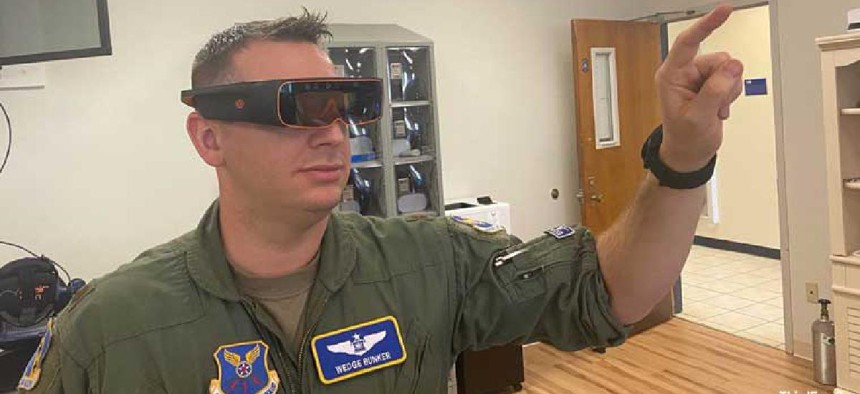AF tests mixed-reality glasses for flight-line maintenance


Connecting state and local government leaders
Mixed-reality glasses are helping airframe maintenance staff with the Air Force’s 7th Bomb Wing improve efficiency by replacing tablets and large manuals.
Mixed-reality (MR) glasses are helping flight crews and flight-line maintenance staff with the Air Force’s 7th Bomb Wing for the B-1 do their jobs more efficiently and safely.
Using X2 MR Glasses by ThirdEye Gen, a maker of augmented- and mixed-reality solutions, and software from 3D Media, which specializes in AR and virtual-reality solutions, the unit is testing how it can use the solution for its maintenance processes. The glasses replace the tablets or large manuals that crews typically carry with them. They can overlay instructions on the machines, show PDFs or images and allow for remote support from others who can tap into the glasses to see what the wearers see.
“That is something that is really helping save time. It can improve efficiency, improve safety,” said Nick Cherukuri, founder of ThirdEye.
The setup uses a proprietary version of SLAM tracking, which stands for simultaneous localization and mapping. It allows for system and computer-aided design modeling and overlays, where step-by-step technical instructions and drawings project onto the glasses’ display. The glasses also take screenshots and enlarge images for better visibility. Users can open and view documents via voice command, while working on maintenance tasks with their hands.
“By using SLAM, you can have instructions overlaid onto a machine or mainframe within a couple millimeters’ accuracy, and because SLAM understands the environment around you, the digital instructions remain in place, so someone could wear the glasses, look at a machine, leave the room, come back and the instructions are still overlaid accurately,” Cherukuri said.
Whereas VR blocks out the real world and creates a virtual one, and AR displays additional information about the real world in front of the user, MR takes AR and SLAM to enable users to interact with the environment around them. For instance, users can display a hologram and walk around it because the glasses understand where they are and their position in the room.
“I believe that augmented reality’s largest opportunity is in the area of human performance, where there’s no margin for error,” 3D Media CEO and founder Daryl Roy said in a statement.
The glasses run on the Android operating system, rely on a strong internet connection and have 5G capabilities that will be augmented by the new wireless network as it develops, Cherukuri said.
AFWERX, the Air Force’s innovation program, awarded 3D Media a $1 million Small Business Innovation Research contract in November 2019 to build AR tools to improve training. Service members have used about 12 pairs of glasses during the pilot that’s been in progress for more than a month, and the company will be sending more.
ThirdEye has a long track record of working with government and plans deployments for the glasses with other military branches, primarily for training purposes, Cherukuri said.
Weighing 300 grams, or about 10.6 ounces, and ruggedized to withstand a 6.5-foot drop onto concrete, the X2 MR Glasses are one of a few on the market that use SLAM. Others include Microsoft’s HoloLens and Magic Leap’s glasses.




